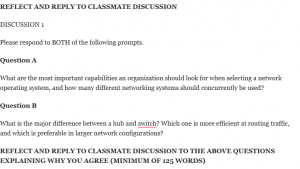REFLECT AND REPLY TO CLASSMATE DISCUSSION
DISCUSSION 1

Please respond to BOTH of the following prompts.
Question A
What are the most important capabilities an organization should look for when selecting a network operating system, and how many different networking systems should concurrently be used?
Question B
What is the major difference between a hub and switch? Which one is more efficient at routing traffic, and which is preferable in larger network configurations?
REFLECT AND REPLY TO CLASSMATE DISCUSSION TO THE ABOVE QUESTIONS EXPLAINING WHY YOU AGREE (MINIMUM OF 125 WORDS)
CLASSMATE’S DISCUSSION
Question A
The choice of network operating system can have major implications for an organization and must be made carefully. Organizations need to consider what the purpose of the network will be, focusing on any required features of the network operating system. If unique or specific hardware is already in use or is planned to be used, it must be checked for compatibility. Similarly, if specific applications or services are required, they need to be checked for compatibility with the considered NOS. The direct cost of the NOS needs to be addressed as well as any support costs. One final consideration is the knowledge and skills of both the network administrators and users. If the proposed NOS is not well known, either or both groups may require additional training to become proficient in their tasks.
Question B
Both hubs and switches allow multiple devices to communicate across the same physical network or bus. Hubs transmit all data packets received on the bus to all devices on the bus, essentially making every packet a broadcast packet. This means that whenever any device is transmitting, no other device can transmit. This limitation is known as half-duplex and reduces the maximum throughput of the network by at least half. Switches transmit packets only to the port identified with the destination address. If the switch does not know which port should be utilized, it will send a short broadcast packet looking for the intended address. Once all devices are assigned to a port on the switch, the switch can allow all devices to function in full duplex mode, meaning that they can transmit and receive at the same time and utilize the full bandwidth capacity of the network. Hubs are typically more cost efficient and more efficient at transmitting packets because there is no processing on the hub itself. However, switches allow the network to be more efficient and are preferred in larger network configurations because they limit the broadcast scope to a single port rather than the entire bus as the hub does. This also reduces the risk of a broadcast storm. A broadcast storm occurs when a corrupted or misconfigured packet is continuously retransmitted as a broadcast. In a hub configuration, this packet would continue to clog all network utilization, especially if multiple hubs were in use. In a switch configuration, the storm may continue on a link between two switches but would not impact connectivity between the switch and other devices.
DISCUSSION 2
Please respond to BOTH of the following prompts.
Question A
What are the most important capabilities an organization should look for when selecting a network operating system, and how many different networking systems should concurrently be used?
Question B
What is the major difference between a hub and switch? Which one is more efficient at routing traffic, and which is preferable in larger network configurations?
REFLECT AND REPLY TO CLASSMATE DISCUSSION TO THE ABOVE QUESTIONS EXPLAINING WHY YOU AGREE. (MINIMUM OF 125 WORDS)
CLASSMATE’S DISCUSSION
Question A
When selecting a network operating system, organizations have to consider the resource requirement, network security, and locations. Some examples of resource requirements are identifying the types of programs that will be used, how many users, files sharing (share drives), share point and internet speed, and will the organization support teleworking. All this will drive the type of operating system that will be used (Microsoft server, Linux, Unix, ect..) in the local area network (LAN) and server requirement. Or does the organization go to cloud services?
Network security is another important capability organizations should consider. User validation and how do you protect the organizations files, PII, and other sensitive information from hackers or insider threats. The organization’s location is also an important aspect to consider because this will identify the organization’s LAN connection type (wireless or wired), how many different sites, and the type of network to be used in certain locations.
Question B
A hub is a device that connects computers within a network and when a hub receives network traffic, it will broadcast the traffic it receives to all the ports or connected computers. A switch is similar to a hub as it connects computers within a network. However, a switch will route the traffic it receives to the intended recipient. According to White, a switch will isolate the traffic flow between segments of the network by examining the address of the transmitted frame and directing the frame to the appropriate port (2016, p. 202) . It is an efficient way of managing data or network traffic within a network. If you want to expand a LAN, you will have to use a switch.